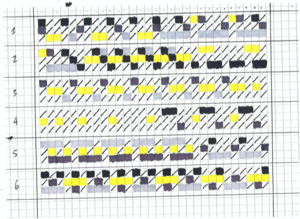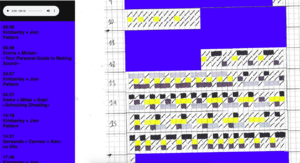Uneven pattern: Difference between revisions
| Line 17: | Line 17: | ||
[https://pad.xpub.nl/p/SI18_TWO_uneven_patterns See complete proposal.] | [https://pad.xpub.nl/p/SI18_TWO_uneven_patterns See complete proposal.] | ||
=Notation= | ==Notation== | ||
Following Steve's introduction on notation systems, a set of instruction was imagined to compose jingles wrapping the different contributions: | Following Steve's introduction on notation systems, a set of instruction was imagined to compose jingles wrapping the different contributions: | ||
<blockquote> | <blockquote> | ||
Revision as of 17:03, 20 June 2022
Uneven pattern was the title for the second release of Radio Implicancies (Special Issue 18) proposed by Carmen, Jian and Kimberley.
Proposal
The following instructions were given to the group:
Dear XPUBies,
yet another adventurous week of sound experiments lies ahead of us and since next Tuesday we will publish episode TWO already, we thought it would be nice to start experimenting with editorial approaches. So for next week's contribution we would like to invite you to work on "UNEVEN PATTERNS" as a common practice. We thought of this motto as a way to approach things rather than a content itself. So feel free to interpret or implement "UNEVEN PATTERNS" in your sound pieces. Of course you can continue to work on your specific interests and incorporate all the tools and methodologies we went through this week. Please read the following notes carefully.
We hope you have fun with it!
Your caretakers: Carmen, Kimberley and Jian
Notation
Following Steve's introduction on notation systems, a set of instruction was imagined to compose jingles wrapping the different contributions:
Title: Uneven pattern
Duration: 6'23
Description: Apply the principles of weaving techniques to create a visual pattern (notation sheet) and translate into an audio piece. The audio piece is intended to bind several contributions together and can be “cut” to insert other sound pieces.
Score, prompt, general overview: Designing a notation system using a simple grid to translate a visual pattern into a sound pattern.
Input: Various audio recordings
Tools: Miscellaneous objects to create sound, microphone to record, Audacity to edit and arrange sound
Process log:
SOUND SAMPLES
1. Defining a number of elements to use in the pattern (in this case: 4)
2. Record as many sound samples as the number of elements defined in the previous step using a variety of mundane objects.
3. Define a unique length for all elements.
NOTATION SHEET
1. Define the length of the sound piece.
2. Horizontal axis: Divide the length of the sound piece by the length of the sound samples previously defined.
3. Vertical axis: Define an amount of track (or ‘layers’)
4. Trace a grid respecting the numbers previously defined.
5. Define a colour for each sound sample.
6. Colour cells to create a pattern.
note: Silent cells are marked with a ‘/’.
INTERPRETATION
1. With a sound editing software, convert the notation sheet in a sound piece by manually arranging the sound samples in their respective positions (defined by the coloured pattern).
note: Silence cells will be translated to silent break which length equals to the sound sample’s length.
2. Export as mp3.
note: Externally designed sound pieces can be inserted in the pattern. To do so, create the insert in the notation sheet first, and make the insert in the sound file by placing the new sound according to its position in the notation sheet.
Who: Jian and Kimberley
Uneven pattern
As an introduction to the listening session, the following text was read to the audience:
Welcome the sound. Free your gaze, let it wander, see but do not look. Closing your eyes is also a possibility. Once the sound is received, start paying attention to it:
Do you recognise similarities?
Can you identify repetitions?
Can you decipher a logic?
Fall into a comfortable loop until meeting the first disturbance...
Finally, look for:
surprises, subversions and singularities of all kinds.
Follow the irregular outline of our uneven patterns.
The jingle's notation sheet was split in parts and blue blocks were inserted to represent the length of each contribution.


